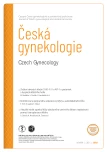Combined peripartal pubic symphysis and sacroiliac joint separation
Authors:
Hriň T. 1; Gajdoš R. 1; Dókuš K. 2
Authors‘ workplace:
II. klinika úrazovej chirurgie SZU a FNsP F. D. Roosevelta, Banská Bystrica, Slovenská republika
1; II. gynekologicko-pôrodnícka klinika SZU a FNsP F. D. Roosevelta, Banská Bystrica, Slovenská republika
2
Published in:
Ceska Gynekol 2021; 86(1): 30-35
Category:
Case Report
doi:
https://doi.org/10.48095/cccg202130
Overview
Objective: We present a case and provide an overview of the literature on rare pelvic girdle injury following spontaneous delivery with combined transsymphyseal and transiliosacral instability, its diagnosis and surgical treatment.
Case report: Injury of the pelvic girdle during childbirth is one of the rare obstetric complications. Due to its low prevalence, the standard treatment algorithm is not defined. We present the case of a 27-year-old primipara with a combined separation of the symphysis and sacroiliac joint after spontaneous childbirth, which did not become clinically apparent until several hours later. After the assessment of clinical findings and results of imaging examinations, we indicated the patient for surgical revision due to significant pain syndrome and movement restrictions. Under general anesthesia, we reduced symphysis in an open manner and fixed it with a pelvic plate. We also fixed the injured sacroiliac joint after a closed reduction with a percutaneously inserted iliosacral screw. On the second postoperative day, the patient was mobilized on crutches. On the fourth postoperative day, the patient was discharged from the hospital. The patient was followed up at regular intervals postoperatively. One year after the injury, the pelvic girdle is clinically stable and the patient has no complaints.
Conclusion: An injury of the pelvic girdle should be considered whenever postpartum patient complains of pain in the area of the symphysis or sacroiliacal joints after natural delivery. In such a case, after a basic imaging diagnosis, a consultation with a specialist with experience in the treatment of pelvic injuries is appropriate. When selecting the most appropriate surgical technique, the nature of injury itself and also early patient mobilisation to be able provide adequate care for her newborn, should be taken into account. Early surgical treatment using stable osteosynthesis helps to address this requirement.
Keywords:
peripartal pubic symphysis separation – combined transsymphyseal and transiliosacral instability – surgery
Sources
1. Nitsche JF, Howell T. Peripartum pubic symphysis separation: a case report and review of the literature. Obstet Gynecol Surv 2011; 66 (3): 153–158. doi: 10.1097/OGX.0b013e31821f84d9.
2. Yoo JJ, Ha YC, Lee YK et al. Incidence and risk factors of symptomatic peripartum diastasis of pubic symphysis. J Korean Med Sci 2014; 29 (2): 281–286. doi: 10.3346/jkms.2014.29.2.281.
3. Joosoph J, Kwek K. Symphysis pubis diastasis after normal vaginal birth: a case report. Ann Acad Med Singap 2007; 36 (1): 83–85.
4. Dunivan GC, Hickman AM, Connolly AM. Severe separation of the pubic symphysis and prompt orthopedic surgical intervention. Obstet Gynecol 2009; 114 (2 Pt 2): 473–475. doi: 10.1097/AOG.0b013e3181998bd1.
5. Jain S, Eedarapalli P, Jamjute P et al. Symphysis pubis dysfunction: a practical approach to management. Obstet Gynaecol 2006; 8 (3): 153–158. doi: 10.1576/toag.8.3.153.27250.
6. Lasbleiz J, Sevestre FX, Moquet PY. Using an elastic band device after a severe obstetric pubic symphyseal separation: clinical and imaging evaluation. Obstet Gynecol 2017; 130 (3): 625–629. doi: 10.1097/AOG.0000000000002194.
7. Idrees A. Management of chronic symphysis pubis pain following child birth with spinal cord stimulator. J Pak Med Assoc 2012; 62 (1): 71–73.
8. Kharrazi FD, Rodgers WB, Kennedy JG et al. Parturition-induced pelvic dislocation: a report of four cases. J Orthop Trauma 1997; 11 (4): 277–282. doi: 10.1097/00005131-199705000-00009.
9. Nayak SP, Panda CK. Comparison between conservative and surgical management in postpartum pubic symphysis diastasis: a randomized controlled trial. Int J Res Orthop 2017; 3 (6): 1211–1217. doi: 10.18203/issn.2455-4510.
10. Hofierková J. Traumatická ruptura spony při vaginálním porodu – kazuistika. Ceska Gynekol 2016; 81 (3): 222–227.
11. Chang JL, Wu V. External fixation of pubic symphysis diastasis from postpartum trauma. Orthopedics 2008; 31 (5): 493. doi: 10.3928/0147 7447-20080501-05.
12. Hiesterman TG, Hill BW, Cole PA. Surgical technique: a percutaneous method of subcutaneous fixation for the anterior pelvic ring: the pelvic bridge. Clin Orthop Relat Res 2012; 470 (8): 2116–2123. doi: 10.1007/s11999-012-2341-4.
13. Groer ME, Jevitt C, Ji M. Immune changes and dysphoric moods across the postpartum. Am J Reprod Immunol 2015; 73 (3): 193–198. doi: 10.1111/aji.12322.
14. Hou Z, Riehl JT, Smith WR et al. Severe postpartum disruption of the pelvic ring: report of two cases and review of the literature. Patient Saf Surg 2011; 5 (1): 2. doi: 10.1186/1754-9493-5-2.
15. Khorashadi L, Petscavage JM, Richardson ML. Postpartum symphysis pubis diastasis. Radiol Case Rep 2015; 6 (3): 542. doi: 10.2484/rcr.v6i3.542.
16. Giannoudis PV, Chalidis BE, Roberts CS. Internal fixation of traumatic diastasis of pubic symphysis: is plate removal essential? Arch Orthop Trauma Surg 2008; 128 (3): 325–331. doi: 10.1007/s00402-007-0429-1.
Labels
Paediatric gynaecology Gynaecology and obstetrics Reproduction medicineArticle was published in
Czech Gynaecology

2021 Issue 1
Most read in this issue
- Adverse events of PARP inhibitors
- Combined peripartal pubic symphysis and sacroiliac joint separation
- Aspects of embryo selection and their preparation for the formation of human embryonic stem cells intended for human therapy
- Eating disorders in the ambulance of pediatric and adolescence gynecology
